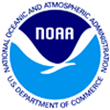Earth Science Week Classroom Activities
Your Own El Nino

Activity Source:
Adapted with permission by the National Weather Service from Discover Your World with NOAA: An Activity Book
Background
El Niño storms have taken thousands of lives and caused billions of dollars in damage in recent decades. Where do these storms come from? Every two to seven years, trade-winds in the Pacific Ocean slow down or reverse their direction — no one is sure why.
Normally, the Pacific trade winds blow vigorously towards the west. This causes warm surface water to pile up in the western Pacific, so that the sea surface is actually about 1/2 meter higher at Indonesia than at Ecuador. These winds also cause sea surface temperatures to be about eight degrees Celsius higher in the west, with cool temperatures off South America, due to an upwelling of cold water from deeper levels.
But when the trade winds slow down, everything changes. Water temperatures become warmer in the eastern Pacific and colder in the west. Nutrient upwelling slows, and fish populations become much smaller along the Pacific coast of South America. Rainfall follows the warmer water, causing flooding in Peru and drought in Indonesia and Australia.
Because these changes can be highly destructive, advance warning of El Niño’s approach is important for emergency preparation. NOAA satellites are constantly collecting information on sea surface temperatures around the globe. NOAA also operates a network of buoys that measure temperature, currents, and winds in the tropical Pacific Ocean.
Here’s how to create a miniature El Niño in your own kitchen!
Materials
- Clear plastic rectangular container, about 18 inches long, four inches high, and four inches deep (such as a food storage container)
- Water
- Mineral oil, about one cup
- Food coloring
- Hair dryer
- Funnel
- Red oil-based paint, about one ounce (two tablespoons)
Procedure
Word of caution: Have an adult help with the hair dryer, and be careful with any electrical appliance around water! Follow warnings on the paint container label concerning ventilation and handling.
1. Fill the plastic container with water to within one inch of the top.
2. Add food coloring to the water. (Blue is good, since we’re dealing with the ocean.) Allow some of the food coloring to settle to the bottom so you can demonstrate upwelling.
3. Pour the mineral oil into a dish and mix in one to two tablespoons of the red paint.
4. Hold the funnel so that the narrow end is against the side of the container, just above the surface of the water. Gently pour mineral oil through the funnel onto the surface of the water.
5. The liquids in the plastic container represent the warm layer of surface water (the mineral oil) and the cold deep water (colored water) in the Pacific Ocean. Turn on the hair dryer and point it into one end of the container. This end represents the eastern side of the Pacific Ocean. Notice that the “warm” water piles up in the western end of the container. This is the normal condition for the Pacific Ocean near the equator. If your food coloring contained sediment particles, you may see these moving upward toward the water surface at the eastern end of the container — just like upwelling in the eastern Pacific!
6. Turn off the hairdryer, and watch what happens when the trade winds stop.
